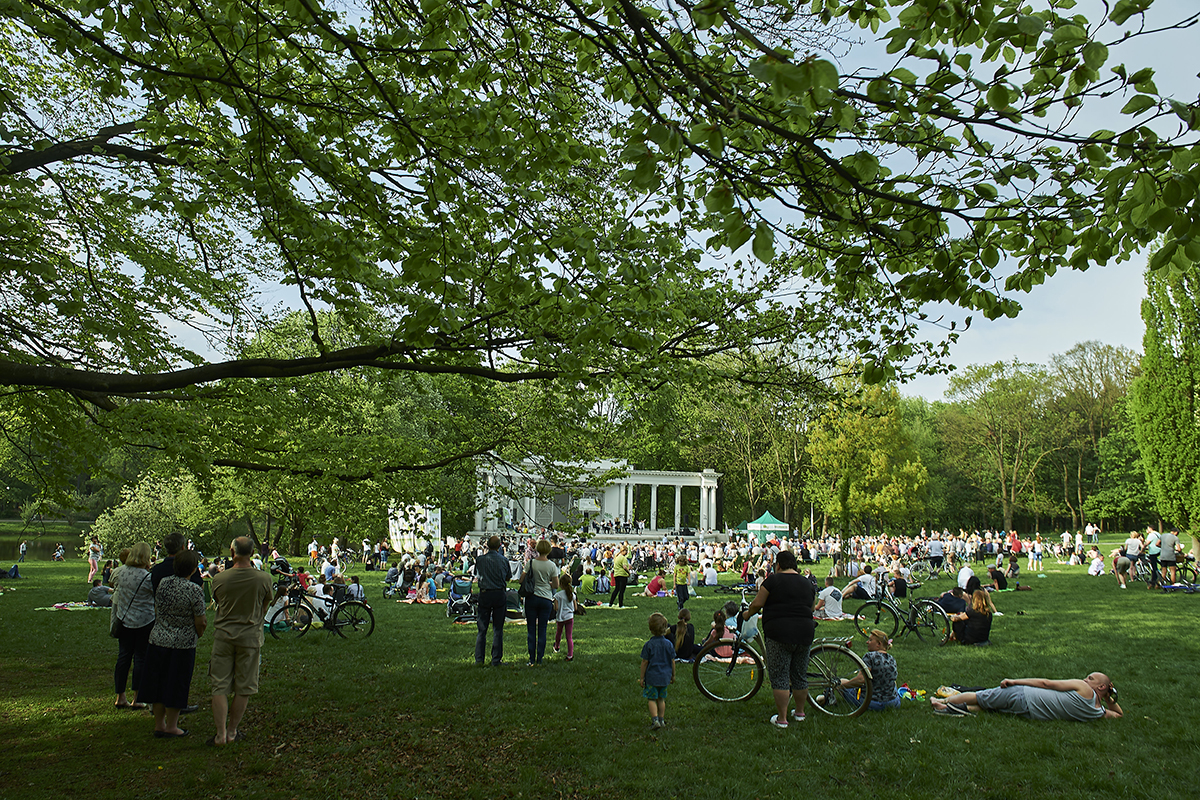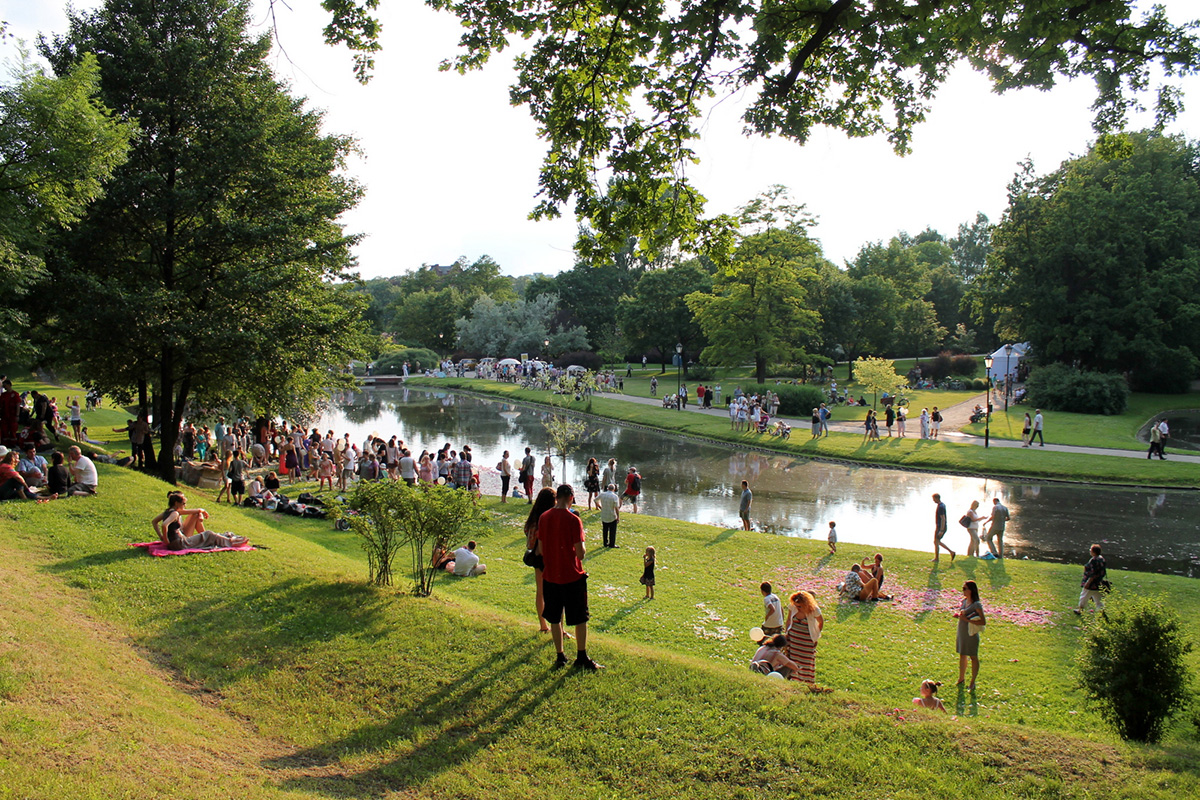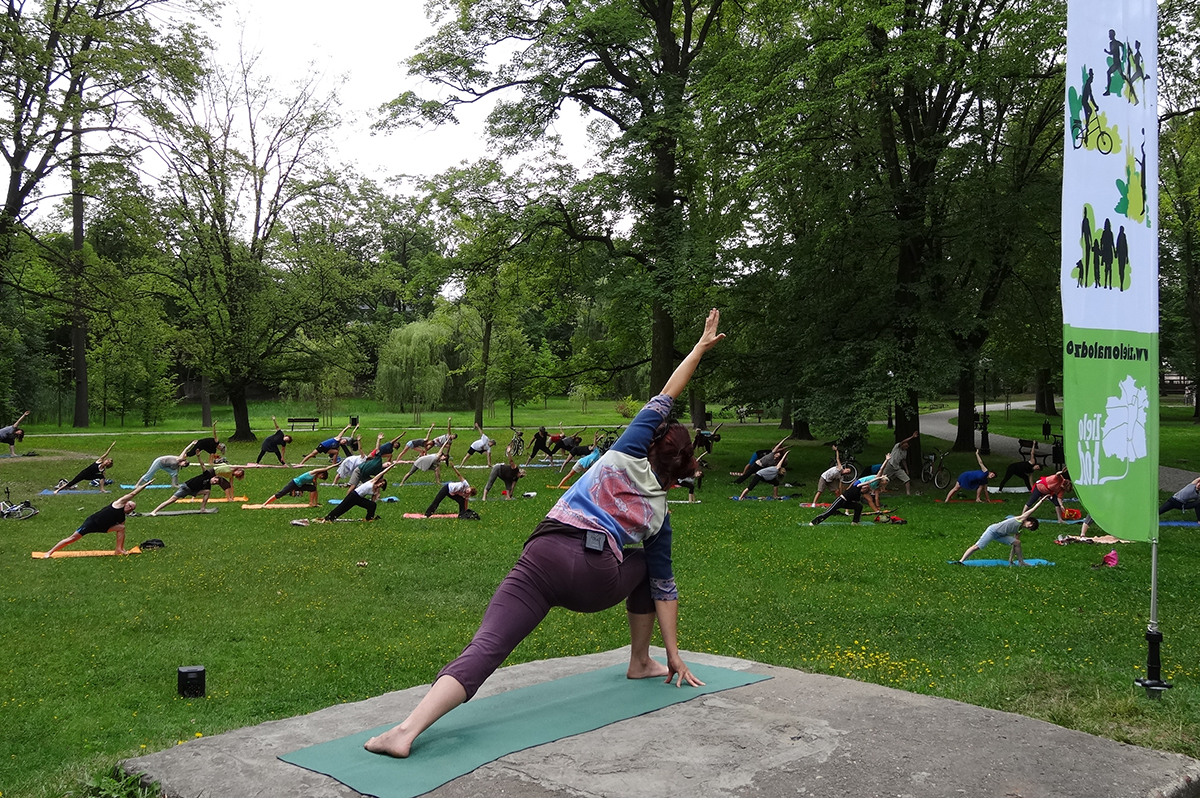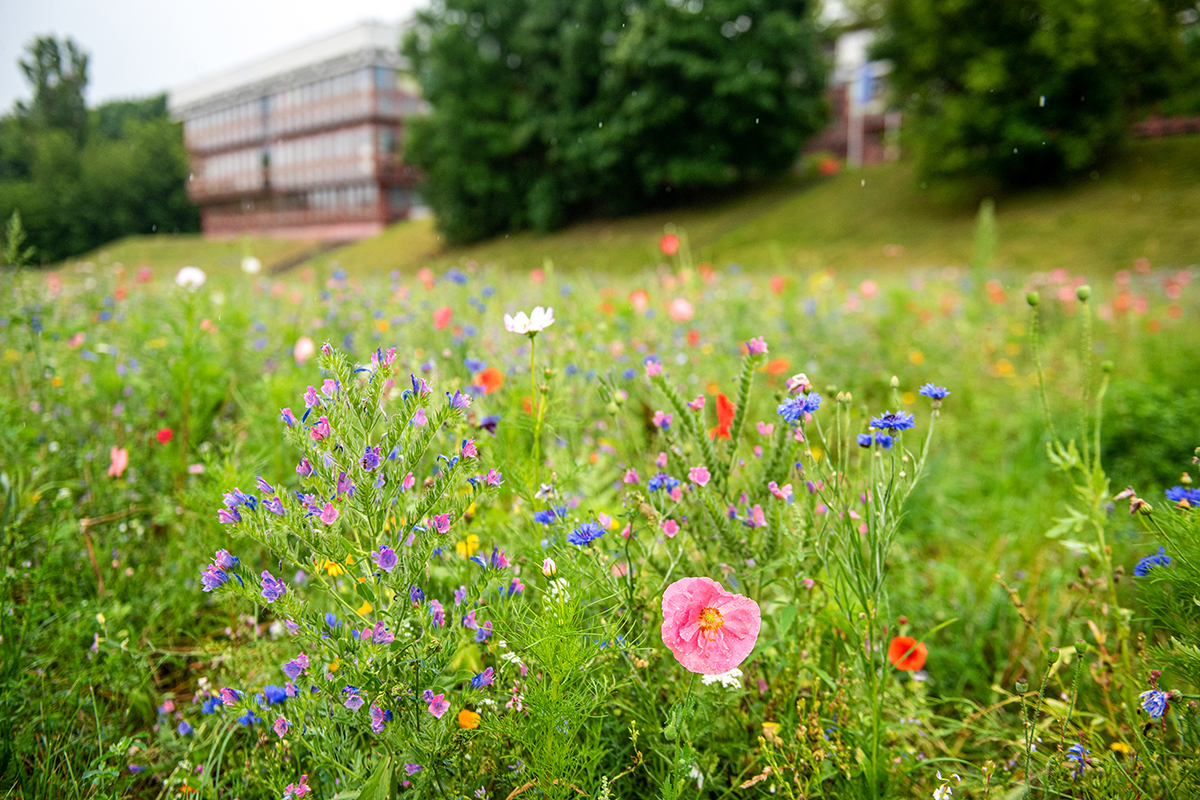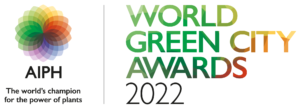Addressing the urban challenge
Breadth of the issue – How are the problem(s) that are being tackled by your initiative affecting citizens/local businesses or a significant component of the local wildlife?
The creation of the “Green Trail” is a general concept of changes in the city aimed at enhancing its green face by increasing the quality of green areas – parks, public spaces, and other attractive facilities. As a result, it is planned to create 6 thematic paths: Historical Parks, Traces of Revitalization, Sports and recreation, Water and environment in the city, Local Communities, Cultural heritage. The individual components of the Green Trail are perfect exhibition space for green events (e.g., trade fairs) or environmental education activities – open-air nature workshops. Thanks to the possibility of co-creating individual elements of the Green Trail, a positive bond is built, social integration takes place, and the sense of community and responsibility for the created place increases.
The Green Trail is also a tribute to biodiversity, which is the key to maintaining natural balance. Thanks to the renovation of parks and the creation of smaller green areas, new plantings will be used, appropriately selected for the area, and fulfilling specific functions, the area of community gardens, including vegetable gardens and flower meadows, ideal for pollinators, will be expanded.
Depth of the issue – How seriously are the problems being tackled by your initiative impacting the life of the citizens/businesses/wildlife concerned?
The problems associated with the urban heat island not only cause discomfort but can also endanger human health – mainly for children or the elderly, causing diseases and premature deaths due to heat stress or air pollution. The temperature difference between city centres, where there is relatively little greenery, and the suburbs, where there is more of it, can even reach 4 Celsius degrees. Conclusion is clear: to make the city friendly to residents is to invest in green infrastructure, which has an important role in improving the living conditions in the city, increasing its comfort. Green alleys and permeable parking lots and sidewalks, unlike concrete, allow air and water to circulate and thus reducing drainage problems. Due to the reduced water retention and evaporation, they also have cooling features. Trees produce oxygen, lower the temperature, moisturize, and purify the air. They also have positive effect on human well-being. The concept of Green Trails is a project that emphasizes the importance of urban nature and improves the quality of life in the city. In terms of the management of green resources, it is an opportunity to introduce innovative technologies for greenery in urban areas. In terms of water resource management, it is the use of rainwater as a resource for the small retention system and water-permeable surfaces. In terms of caring for the quality of the climate, it is a solution that minimizes the urban heat island and improves air quality thanks to the increase of biologically active areas.
The power of plants and natural ecosystems to deliver benefits
How is the initiative shaped by scientific evidence of the potential for plants and natural ecosystems to deliver benefits?
The construction of Green Trails was made taking into account the assumptions of the Blue – Green Network. It is an urban concept assuming the creation of a coherent network of interconnected green areas surrounding the entire city, most of all areas along river valleys. The originator of the project is the Centre for Ecohydrology of the Polish Academy of Sciences operating under the auspices of UNESCO. The idea is to create a network of high-quality parks, forests, and green recreational areas for the city’s residents, which will have a positive impact not only on the condition of the natural environment (reduction of smog, providing airing corridors in the city, improvement of air humidity, etc.), but also on the quality of life of residents. (Possibility of active rest and physical activity improving health condition, etc.). The development of cities is associated with a meteorological phenomenon called the urban heat island. It results mainly from a significant change in the environment of urban areas, which influences the transformation of their properties: radiation, thermal, aerodynamic or humidity. The most reliable indicator of the intensity of this phenomenon is the difference in temperature between the city and suburban areas. Creating green infrastructure, i.e., a network of urban green areas, is one of the activities aimed at levelling the urban heat island. In densely built-up urban tissue, it is necessary to saturate it with solutions that will alleviate thermal conditions and reduce heat stress of residents in everyday situations.
How has the city exploited the potential of plants and associated ecosystems to deliver more than one benefit?
The implementation of the Green Trails concept is:
- Creating a favourable microclimate – as part of the revalorization of parks and other green spaces additional plantings are foreseen, maintenance of the existing greenery and pro-ecological solutions aimed at developing small retention (e.g. rain gardens, green roofs and green walls).
- Exposing the role of water and the environment in the city – one of the planned thematic paths is stretched between the valleys of the Jasień, Łódka and Sokołówka rivers and also connects areas with water elements located in the central part of the city. The path will be not only a tourist attraction for visitors, but also have educational value, as experts in this field – the Centre for Ecohydrology of the Polish Academy of Sciences and the Lodz University of Technology are going to be involved.
- Smart city solutions – “compact city”, „resilient city” – shaping resident-friendly public spaces by revitalizing parks and creating local, smaller green spaces, e.g. community gardens, squares, pocket parks to which the residents have quick and easy access.
- Building a positive relationship, social integration, a sense of community (thanks to a dedicated municipal subsidy, residents can create their own green areas, community gardens, etc.; thanks to the developed line of cooperation with business (EKOpakt), private companies contribute to the creation of new squares, pocket parks, meadows flowers.
Innovative and Collaborative Solution
How does the initiative show evidence of feasibility, including on-going financial and logistical support?
Green Trails is a concept of changes in the city aimed at enhancing its green face by increasing the quality of green areas. The document enabling revitalization activities is Commune Revitalization Program. A special place in it is occupied by 8 projects of Areal Revitalization of the Centre of Łódź, co-financed from EU funds. It also included the revalorization of historical parks, which are the main points of the Green Trails. In 2019, historical composition of Sienkiewicza Park has been restored and Moniuszki Park was renovated: there were built new alleys with various surfaces and planted trees, shrubs and perennials. The revalorization of the Staromiejski Park is planned for 2022. The aim here is to show the historic layout of the former Jewish district with the help of plants. There will be created a new viewing axis, following the natural course of Łódka River. In 2020, Łódź received funding the project “Re: Neval of Helenów Park”. In addition to the renovation of the park itself, it is also planned to develop a connection with the neighbouring areas: Ocalałych Park and Staromiejski Park, as part of the Green Trails. Green infrastructure is also enriched by smaller investments, proposed by the residents themselves through the annual Plan for estates programme (e.g., revalorization of the Legionów Park) and civic budget (e.g., nesting boxes for birds, houses for insects). Thanks to Ekopakt, an initiative launched in 2020, the city has created 5 flower meadows and 15 community gardens. And it is only a beginning.
In what ways is the initiative innovative?
The terms “innovative” and “smart” do not have a single accepted definition, although many proposals have appeared over the years. Colloquially, a smart city is understood as an urban area that uses new technologies to improve the quality of public services provided, but the emphasis on technology is diminishing in favour of solutions closer to people. Increasingly, “smart” are the cities inviting its inhabitants to co-decide, putting them at the centre of attention, and implementing solutions that would respond to their problems. There is a strong emphasis on developing the competences of the inhabitants. One of the features of a smart city is resilience – including resilience to climate change. It indicates that the city is one organism, a system of connected vessels, in which residents, authorities and entrepreneurs have to work together to create solutions optimal for everyone. Only such urban centre can develop in a sustainable manner.
The concept of Green Trails refers to such understanding of innovation. Inviting residents and local business to co-create routes by creating their own green spaces, and thus spreading knowledge about the importance of greenery in reducing the negative effects of climate change – this means „smart” and „innovative” for Łódź.
How is the initiative supported by collaborative working across disciplines and sectors?
The city is one organism, a system of interconnected vessels in which residents, authorities and entrepreneurs have to work together to create solutions that are optimal for everyone. Only such a centre will be resilient and sustainable.
That is why EKOpakt was created – an agreement with a wide group of stakeholders aiming at doing something useful for the environment. Thanks to the involvement of external entities, we were able to create flower meadows, community gardens in the city area, and green public squares, which can successfully become next points on the Green Trail route, creating new branches and growing like a tree. Cooperation with the scientific community – universities and other educational institutions is also of great importance here.
In addition, special cash subsidies were launched for residents, thanks to which they can create their own small retention systems and green spaces. The most interesting of them may also become part of the Green Trail.
How does the initiative demonstrate evidence of community support?
The proof of co-building a green city is EKOpakt, which is a form of cooperation between the city and entrepreneurs, institutions, schools. In 2021, as many as 30 entities decided to cooperate, donating not only money – although the number of PLN 0.5 million is impressive – but also their time and commitment. Thanks to them, new green areas have been created – flower meadows, squares and community gardens, which will become elements of the Green Trails. A form of cooperation with residents was the Citizens’ Panel: Green in the city. A selected group of residents developed recommendations for the city authorities in the field of greenery, taking into account the common good of all Łódź residents. Thanks to their votes, parks, which are elements of Green Trails, were enriched with new plantings, flower meadows and community gardens were created, which will become interesting complementary elements of Green Trails. An example of cooperation with external entities is also the subsidy program ZazieleniaMY launched in 2021. Thanks to the financial support of the city, the beneficiaries, placed in the revitalization territory, were able to create local green areas themselves. The program was launched to encourage the inhabitants to take actions that contribute to limiting the negative effects of climate change. By greening their own backyard, each of the beneficiaries contributes to improving condition of the surroundings. As the program growth, it is planned to create a catalogue of the most beautifully landscaped spaces, as an element complementing the Green Trails.
Implementation, Impact and Replicability
How does the initiative demonstrate evidence of a track record of success against pursued objectives?
The natural environment and its condition are factors determining the quality of the city and well-being of inhabitants. Greenery in the city has important functions, bringing health benefits to its residents. Parks, lawns, housing estate greenery and street greenery are close to its users and that provides an everyday contact with nature. This kind of greenery is most noticeable to local residents, at hand and widely available. Cities in large areas of this kind of greenery have greater potential in terms of balanced functional and spatial structure. Sustainable development is one of the main principles of spatial planning – along with the principle of spatial order (the Act on spatial planning and development). It is also compliant with the environmental protection law: sustainable development means integration political, economic, and social matters, maintaining natural balance, in order to covering basic needs for present and future generations.
With the values of greenery in mind, it was established the document in terms of Shaping, maintaining, and protecting greenery in Łódź. It is addressed to all those responsible for shaping and maintaining green areas: officials, area managers, designers, and supervisors.
It is also planned to study the ecological effect of the implemented solutions in order to illustrate the need to create new green areas. A strategic approach, supported by relevant documents and orientation to well-being of Łódź dwellers are the decisive factors for the success of the Green Trail project.
How has the initiative had a ripple effect beyond the scope of the initiative itself, thereby demonstrating a change in the city’s and/or its partners’ way of working with plants?
As emphasized earlier, Green Trails are much more than just marked out routes. This is an ideological program related to the promotion of green solutions in the city. The keynote revolves around the major challenges faced by modern cities and societies. Green Trails are in line with the idea of promoting pro-environmental solutions, favouring the minimization of the negative impact of humans – especially city dwellers – on nature. The designed solutions are aimed at drawing attention to the role of the environment in the city, promoting the idea of sustainable development, improving the quality of life through greenery. Green Trails were created to increase social awareness – to make the thoughts related to the environment and the need to protect it constantly present in the minds of the city’s inhabitants.
Another idea behind this concept is co-creation. Thanks to the possibility of having an individual input to the project, positive bonds are built, social integration takes place, and the sense of community and responsibility for the co-created place increases. EKOpakt also allows the business community to engage in ecological activities, which has a positive impact on changing negative habits within these organizations.
The individual components of the Green Trail are also excellent exhibition spaces for greenery events (e.g., trade fairs), or environmental education activities – open-air nature workshops. These activities because that being together in greenery is a part of everyday human activity, thanks to which the aspect of its protection becomes something natural, unforced.
How have other cities expressed interest in the initiative, or what potential does it have to interest other cities and be customised to their own circumstances?
Although cities know that investments in greenery are the right direction, some of them do not know how to implement specific solutions. According to research, in Łódź statistically, per capita there is above 40 m2 of green space – significantly more than in case of residents of other large Polish cities. This fact determines special care of greenery in Łódź and duty to help exchange of knowledge and good practices resulting from the Green Trails implementation. Other European cities who understand the need for a city dweller to contact greenery are Paris and Rotterdam. Carlos Moreno, professor at the University of Paris, is the creator of 15-minutes city theory. Moving short distances means less energy consumption and less pollution. In this approach, greenery and its accessibility play a large role. The Mayor of Paris calls for investments in greening the school’s recreational areas, but with a view to keeping them open to all residents at a certain time. Rotterdam turned out to be a pioneer in the implementation of facade gardens. You do not need any special permits to dismantle a piece of the pavement and create your own garden. More greenery makes the city more resistant to climate change and floods and is good for insects and birds – the city’s website reads. An increasingly common practice is the creation of an eco-estate. In addition to the use of ecological construction solutions, the area of biologically active surface is also taken into account in order to plan the greenery.
Sustainability and Resilience
What efforts have been made to reduce the carbon footprint of the initiative?
The carbon footprint is one of the greatest challenges of the 21st century. Research shows that greenery is the most effective ally in the fight against the carbon footprint. A deciduous tree, about 10 meters high, produces an average of 118 kg of oxygen per year. For comparison, a statistical adult consumes nearly 176 kg per year. Older specimens produce even more: 100-year-old beech trees are able to release 1,200 litres of oxygen into the atmosphere in just one hour, which is equivalent to the work of 1,700 10-year-old specimens. The quoted data from Chicago researchers show that a 30-year-old tree growing on the street is able to absorb up to 54.2 kg of CO2 in a year. That is why trees and greenery are slowly becoming a serious capital. Chicago research reports the contribution of parks to reducing pollution, valued at $ 9.2 million, and each dollar invested in the promotion of green spaces can pay back up to 3 times. In Poland, the analyses of Halina Szczepanowska, a specialist in gardening and urban greenery, speak of the benefits generated by only 352 trees of over 82 thousand złotych. The concept of Green Routes fits perfectly into the greening of cities in order to reduce the negative impact of human activity on the climate. To illustrate this fact, a numerical representation of the environmental effect of the project will help.
How have the anticipated impacts of climate change been considered?
In Green Trails project, the assumptions of the Blue-Green Network were taken into account. The idea is to create a network of high-quality parks, forests and green recreational areas that will have a positive impact on natural environment: smog reduction, providing airing corridors in the city, improving air humidity, etc. Creating a favourable microclimate is also expected through additional plantings, care existing greenery and pro-ecological solutions aimed at developing small retention: rain gardens, green roofs, and green walls. Vegetation is selected according to urban conditions, with an emphasis on non-invasive species, suitable for the current and predicted local microclimate. One of the planned thematic paths, exposing the role of water in the city, stretches between the valleys of the Jasień, Łódka and Sokołówka rivers and connects these areas with water elements located in the central part of the city. The path will be not only a tourist attraction for visitors, but also an educational value it is planned to involve experts in this field – the Centre for Ecohydrology of the Polish Academy of Sciences and the Lodz University of Technology. Green Trails are also a tribute to biodiversity, which is the key to maintaining natural balance. Thanks to the comprehensive renovation of parks and the creation of new, smaller green areas, new plantings will be created, appropriately selected for the area, and fulfilling specific functions, the area of community gardens and flower meadows, ideal for pollinators, will gradually expand.
What processes does the initiative include for it to be considerate in its use of soils and other natural resources?
One of the Green Trail concepts is increasing the quantity and improving the quality of greenery in Łódź, which will cause a change in the philosophy of planning and using city parks. This approach reflects the city’s priorities and is a complementation to the EXPO Horticultural 2029 Łódź Polska exhibition, with its main theme – Nature of the City. It is also an opportunity to draw attention to the technologies supporting urban nature and improving the quality of city life. In terms of management of green resources, these will include innovative technologies for greenery, e.g. aeration and irrigation systems, supporting the introduction of new greenery and maintenance of the existing one; in the field of water resources management – use of rainwater as a resource for the small retention systems, water-permeable surfaces; in terms our climate – solutions minimizing the urban heat island and improving air quality, e.g. increasing biologically active areas, especially trees and greenery catching suspended dust. It is also an opportunity to involve residents in the creation of green solutions and lesson in the field of importance of greenery in reducing negative effects of climate change. To summing up, Green Trails are in line with the idea of promoting pro-environmental solutions that help minimize the negative impact of humans – especially city dwellers – on nature. The designed solutions are aimed at drawing attention to the role of the environment in the city, promoting idea of sustainable development, improving the quality of life through greenery.
Monitoring, Maintenance, and Management
How has the initiative been designed and implemented so that long-term needs for management and maintenance are reduced and can be met?
In order to standardize the quality of design and implementation works in green areas “Standards for shaping greenery in Łódź” was created. Document is addressed to all persons responsible for shaping and maintaining green areas: officials, area managers, designers, work contractors and supervising specialists. The information presented may also be helpful for managers of other public areas. The structure of the study includes standardization in the following areas: protection of green areas during the investment process; urban greenery design; planting greenery; maintenance of urban green areas; requirements for contractors and people involved in the investment process related to greenery. The usefulness of the study results mainly from the awareness of the importance of a properly made dendrological inventory for the correct assessment of the values of the existing high greenery (as an environmental resource of great importance for the quality of life of people), or the principles of greenery protection during the investment process. Such knowledge allows for more effective protection of valuable tall green areas, or shaping of areas and forecasting their functions, with the awareness of the importance of ecosystem services in the urban environment in the situation of progressive climate change. Within the structures of the city hall, there is a dedicated team for managing and coordinating environmental matters, which operates on the basis of standardized internal guidelines. The maintenance of specific areas will be also supervised by dedicated units of the city office, which will take care of the effects of the works carried out.
What protocols are in place to facilitate monitoring of results?
Effective management of urban greenery resources, which includes Green Trails, is possible thanks to its comprehensive inventory. This is achieved by a dedicated map, which is the result of the first stage of the City’s work in the field of inventorying the tall greenery located within the administrative boundaries of Łódź. The information collected on the map concerns the number and type of trees and shrubs and has been marked in the form of points corresponding to individual trees or shrub clusters.
There are plans to extend the functionality of the map so that the data contained therein include diagnostics of the condition of trees, which will allow for rational management of their care. A very useful functionality would also be information to what extent individual urban areas are covered with tree crowns, which would help in understanding the scale of ecosystem services provided by Łódź trees, such as carbon dioxide absorption, oxygen production or minimizing the urban heat island.
In addition, the use of a dedicated application would enable urban greenery keepers to enter data on the location, tree parameters (species, perimeter) and its health status on an ongoing basis, attach photos, and update the information already contained in the city-wide green database. Sharing the map for residents is for them a comprehensive source of information about the city’s greenery, a way to take a closer look at Łódź vegetation.
How has the initiative been enhanced in response to monitoring of results?
The result of the first stage of the City’s work in the field of inventorying the tall greenery located within the administrative boundaries of Łódź is dedicated map. The information collected there concerns the number and type of trees and shrubs and has been marked in the form of points corresponding to individual trees or shrub clusters. This kind of identification help manage urban greenery resources effectively and protect every single tree in Green Trails area. There are plans to extend functionality of the map, so the data include diagnostics of trees condition, which will allow for rational management of their care. A very useful functionality would also be information how individual urban areas are covered with tree crowns, which would help in understanding the scale of ecosystem services provided by Łódź trees, such as carbon dioxide absorption, oxygen production or minimizing the urban heat island. In addition, the use of a dedicated application would enable urban greenery keepers to enter data on the location, tree parameters (species, perimeter) and its health status on an ongoing basis, attach photos, and update the information already contained in the city-wide green database. Sharing the map for residents would be a comprehensive source of information about the city’s greenery for them, a way to take a closer look at Łódź vegetation.

















